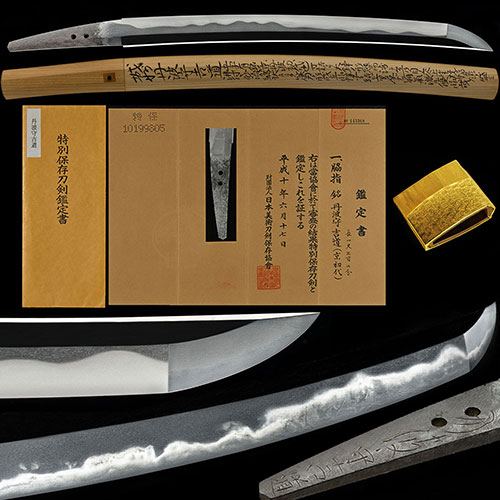
吉道 (京初代) 脇差Yoshimichi(Kyo 初代(first)) Wakizashi
No.524211丹波守吉道 京初代 沸匂深い簾刃湯走り飛び焼き掛り地刃明るく冴える重厚で覇気溢れる最高傑作 一尺三寸二分Tanbanokami Yoshimichi Kyo-Syodai(First) Deep NieNioi, Sudareba, Yubashiri, Tobiyaki-kakari, Jiba is bright and clear, A masterpiece filled with dignity and spirit 40.1cm
ご成約Sold
- 銘表Mei-Omote
- 丹波守吉道 (京初代)丹波守吉道 (京初代) Tanbanokami Yoshimichi
- 登録証Registration
- 埼玉県 Saitama 平成7年9月20日 9/20/7(Heisei)
- 時代Period
- 江戸初期寛永ごろEarly Edo period, around Kanei period
- 法量Size
-
刃長 40.1cm (一尺三寸二分) 反り 0.7cm
元幅 3.1cm 先幅 2.6cm 元重 0.61cm 鎬厚 0.66cm 先重 0.53cm 鋒長 5.2cm 茎長 12.5cm 重量 413gHachou 40.1cm (一尺三寸二分) Sori 0.7cm
Moto-Haba 3.1cm Saki-Haba 2.6cm Moto-Kasane 0.61cm Shinogi-Thikess 0.66cm Saki-Kasane 0.53cm Kissaki-Chou 5.2cm Nakago-Chou 12.5cm Weight 413g - 国Country
- 山城Yamashiro
- 姿Shape
- 鎬造、庵棟、身幅広く、反り浅くつき、大鋒。Shinogidukuri, Iorimune, Wide Mihaba, Shallow Sori-tsuki, Oh-Kissaki.
- 鍛Kitae
- 板目肌に、杢目・小杢目肌交じり、肌立ち、地沸厚くつき、粗めの地沸交え、地景細かく入り、鉄冴える。Itamehada, Mokume, Mixed small-Mokumehada, Hadatachi, Jinie entered thickly, Mixed rough Jinie, Chikei entered finely, Iron is clear.
- 刃文Hamon
- のたれに、互の目交じり、湯走り・飛び焼き頻りに掛り、縞掛かって砂流しがさかんにかかり、沸・匂深くよくつき、匂口明るく冴える。Notare, Mixed Gunome, Yubashiri, Tobiyaki-shikirinikakari, Shinogi-kakatte and Sunagashi entered frequently, Nie, and Deep Nioi entered frequently, Nioikuchi is bright and clear.
- 帽子Boushi
- 帽子、乱れ込んで小丸。Boushi, Midarekonde-Komaru
- 茎Nakago
- 生ぶ、先入山形、鑢目大筋違、目釘孔二。Ubu, Sakiiriyamagata, Yasurime-Ohsujikai, Mekugiana are two(2)
- ハバキHabaki
- 金着二重。Double Kinkise
- 説明Drscription
- 初代丹波守吉道は、三品派の祖である美濃大道(兼道)の三男で、文禄二年(1593年)に父と三人の兄弟(伊賀守金道、和泉守来金道、越中守正俊)とともに上京し、三品派の礎を築いた。文禄四年丹波守を受領、慶長から寛永年間にかけて活躍し、その子孫・門弟も素晴らしい活動を続け、吉道家の名を大いに高めている。初代吉道の作刀には、年紀を有するものは稀れで、元和七年紀の脇差を一口経眼するのみである。「帆掛丹波」とも呼ばれ「丹」の字が右下がりに傾き、帆に風をはらんだような鏨運びが古優で、珍重されている。作風は、彼が創始した簾刃と称される独特の刃文を焼いてその個性を見せている。本作は、身幅広く、先幅広く、大鋒となる慶長新刀の姿で、板目肌に、杢目・小杢目肌交じり、地沸が厚くつき、地景よく入る肌立った美しい地鉄に、のたれて、互の目交じり、足・葉太く入り、湯走り・飛び焼き頻りに掛り、沸深くよくつき、沸筋・砂流し縞状に掛り、彼の創始した簾刃を焼き、重厚で覇気溢れる。後代の作のように技巧的で誇張されたものとは違い、湯走りや砂流しが自然に入り、まだ完全な簾刃ではないところに見どころがあり、迫力と趣が溢れ地刃明るく冴える最高傑作である。The first Tanbanokami Yoshimichi was the third son of Mino Daido (Kanemichi), the founder of the Mishina school. In 1593, he moved to Kyoto with his father and three brothers (Iganokami Kinmichi, Izuminokami Rai Kinmichi, and Ecchunokami Masatoshi) and laid the foundations of the Mishina school.
He received the title of Tanbanokami in 4th Bunroku period and was active from the Keicho to Kanei eras. His descendants and disciples continue to perform with great accomplishments, greatly enhancing the reputation of the Yoshimichi school. Swords made by the first Yoshimichi are rare with dates attached, and only one wakizashi dated 7th Genwa era is known. Also known as "Hokake Tanba," the character "Tan" slants downward to the right, and the Tagane-hakobi, which resembles a sail filled with wind, is an ancient and highly prized style. His style is characterized by the unique Hamon(blade pattern) known as Sudareba, which he created.
This sword has wide Mihaba and wide Sakihaba, This is a Keicho Shinto sword that will become Oh-Kissaki. Itamehada, Mokume and mixed Small-Mokume, Jinie entered thick, Chikei entered with Beautiful Hadatatsu-Jigane, Notare, Mixed Gunome, There are Ashi and You thickly, Yubashiri, Tobiyaki entered frequently, Deep Nie entered well, Niesuji, The Sunagashi stripes are applied. He fires the Sudareba that he created. Stately and powerful, Unlike the more technically exaggerated works of his later period, the Yubashiri and Sunagashi come naturally, and the fact that it is not yet a complete Sudareba is what makes it a remarkable masterpiece, full of power and charm, and Jiba is bright and clear.


